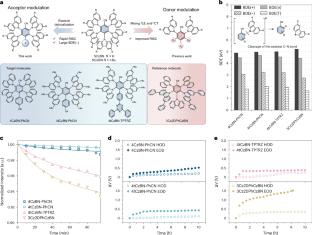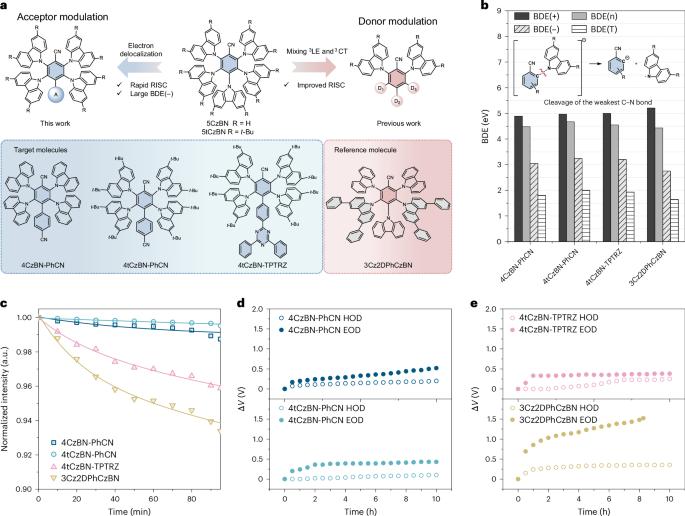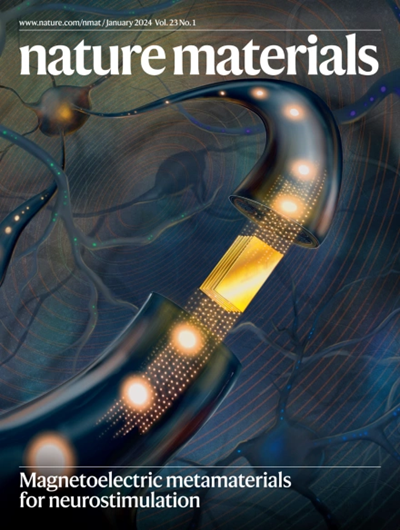Delocalizing electron distribution in thermally activated delayed fluorophors for high-efficiency and long-lifetime blue electroluminescence
IF 37.2
1区 材料科学
Q1 CHEMISTRY, PHYSICAL
引用次数: 0
Abstract
Blue thermally activated delayed fluorescent emitters are promising for the next generation of organic light-emitting diodes, yet their performance still cannot meet the requirements for commercialization. Here we establish a design rule for highly efficient and stable thermally activated delayed fluorescent emitters by introducing an auxiliary acceptor that could delocalize electron distributions, enhancing molecular stability in both the negative polaron and triplet excited state, while also accelerating triplet-to-singlet up-conversion and singlet radiative processes simultaneously. Proof-of-concept thermally activated delayed fluorescent compounds, based on a multi-carbazole-benzonitrile structure, exhibit near-unity photoluminescent quantum yields, short-lived delays and improved photoluminescent and electroluminescent stabilities. A deep-blue organic light-emitting diode using one of these molecules as a sensitizer for a multi-resonance emitter achieves a remarkable time to 95% of initial luminance of 221 h at an initial luminance of 1,000 cd m−2, a maximum external quantum efficiency of 30.8% and Commission Internationale de l’Eclairage coordinates of (0.14, 0.17). The stability and efficiency of thermally activated delayed fluorescent (TADF) emitters are still limited. Here the authors design TADF compounds by introducing an auxiliary acceptor with both enhanced stability and enhanced efficiency.


热激活延迟荧光体中的电子分布去局域化,实现高效率和长寿命蓝色电致发光
蓝色热激活延迟荧光发光体有望成为下一代有机发光二极管,但其性能仍无法满足商业化的要求。在这里,我们通过引入一种辅助受体,建立了高效稳定的热激活延迟荧光发光体的设计规则,这种受体可以使电子分布去局域化,增强负极子和三重激发态的分子稳定性,同时还能加速三重子到singlet的上转换和单重子辐射过程。基于多咔唑-苯甲腈结构的概念性热激活延迟荧光化合物显示出接近统一的光量子产率、短寿命延迟以及更好的光致发光和电致发光稳定性。一种深蓝色的有机发光二极管使用了其中一种分子作为多共振发射器的敏化剂,在初始亮度为 1,000 cd m-2 时,达到初始亮度 95% 的显著时间为 221 h,最大外部量子效率为 30.8%,国际照明委员会坐标为 (0.14, 0.17)。
本文章由计算机程序翻译,如有差异,请以英文原文为准。
求助全文
约1分钟内获得全文
求助全文
来源期刊

Nature Materials
工程技术-材料科学:综合
CiteScore
62.20
自引率
0.70%
发文量
221
审稿时长
3.2 months
期刊介绍:
Nature Materials is a monthly multi-disciplinary journal aimed at bringing together cutting-edge research across the entire spectrum of materials science and engineering. It covers all applied and fundamental aspects of the synthesis/processing, structure/composition, properties, and performance of materials. The journal recognizes that materials research has an increasing impact on classical disciplines such as physics, chemistry, and biology.
Additionally, Nature Materials provides a forum for the development of a common identity among materials scientists and encourages interdisciplinary collaboration. It takes an integrated and balanced approach to all areas of materials research, fostering the exchange of ideas between scientists involved in different disciplines.
Nature Materials is an invaluable resource for scientists in academia and industry who are active in discovering and developing materials and materials-related concepts. It offers engaging and informative papers of exceptional significance and quality, with the aim of influencing the development of society in the future.
 求助内容:
求助内容: 应助结果提醒方式:
应助结果提醒方式:


